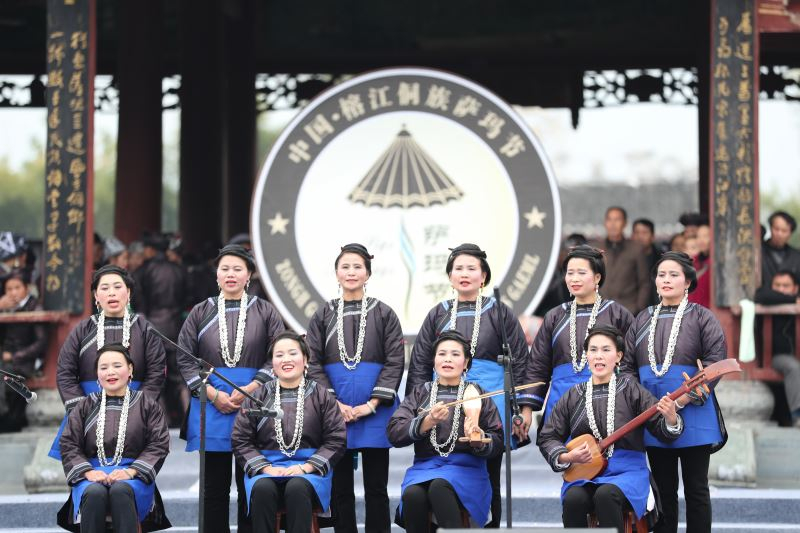
Grand Songs of the Dong
Splendid
Chi Culture
Topic
Grand Songs of the Dong
The Dong are a minority group in China who support themselves mainly through rice production. They are a branch of the Luo and Yue minority groups and for generations have lived along the southern edge of the Yun-Gui Plateau, a border area contiguous to four provinces, namely Guizhou, Hunan, Guangxi, and Hubei. The Dong have a history that goes back more than twenty-five hundred years. They are, as a group, proficient at singing and dancing; in fact, they regard singing as important as life itself. Their songs fall into two categories, for the most part: the so-called grand and lesser songs. The grand songs possess great artistry with majestic momentum and complex musical structures. In 2009, they were inscribed on the UNESCO list of Intangible Cultural Heritage.
Historically, the grand songs of the Dong are found within the southern dialect region; nowadays they circulate mainly in four districts: Liping, Congjiang, and Rongjiang in Guizhou province, and Sanjiang of Guangxi province. These districts are in the second local region of the southern Dong dialect. The term grand song is a collective name for folksongs from a variety of musical systems. The performance consists of one solo singer with a chorus (divided into alto and bass) providing harmony. These polyphonic folksongs have no conductor, no instrumental accompaniment, and no fixed musical scores. Traditional grand songs include various genres: drum tower songs, imitative songs (that is, songs in which sounds from nature are imitated), rousheng (soft and gentle) songs, songs imparting ethics, narrative songs, children’s songs, dramatic songs, and hall-stepping songs.
Compared with grand songs, lesser songs are usually sung in a low voice, with a light sound, and at a slow tempo. Their tunes are short and feelings are indirectly but sentimentally expressed. They are divided into two categories, accompanied and unaccompanied songs. Accompanied songs are often referred to by the musical instrument accompanying the singer. For instance, those songs accompanied by lutes are called “lute songs,” those by niutui (cow-leg) qins, “niutui qin songs,” and those by the flute, “flute songs.” In addition to the lesser songs, there are ritual songs sung at social occasions such as weddings or funerals.
As for musical instruments, the polyphony of the grand songs is closely related to the development of local musical instruments used by the Dong minority. The most common musical instruments include: the Dong flute, lute, niutui qin, reed pipe, reed pipe-flute.
The grand songs are transmitted in a way that is rarely seen in the world: they are transmitted “ear to mouth.” Every village in the Dong tribe region where the grand songs are popular may be seen as a local music school. There, the seniors teach the songs, the young people sing, and the youngest ones learn how to sing. During their singing lessons, students take part in antiphonal style singing and in competitions. Outside of school, they take part in festivals and celebrations. The songs and the education have been inherited over generations.
However, in the early twentieth century, these old songs that had been previously hidden in mountains and villages were discovered by some Han musicians who had been sent to rural regions during the Land Reform period. For the first time these songs were given official titles and their details were documented. At the beginning of the twenty-first century, new variations of Dong grand songs appear that are elegant and sonorous. The choreographic trends of the stage performance have also had an obvious influence on Dong grand songs. It has become a pressing task to preserve and transmit them.
Against the background of modernization, there are important issues of inheritance which concern the role of formal education, the limitations of the traditional methods of transmission, and bringing Dong grand songs into schools. In addition, as the singer-teachers are key figures for the transmission of Dong grand songs, the protection of these songs relies on these singer-teachers. In the meantime, while these questions are being addressed, we should strive to record the artistic achievements of the old singer-teachers. This will help to better transmit, assist, and educate younger singers so as to avoid the tragic rupture caused when an art dies with its creator. The authorities have allocated funds to support the organization of Dong singing competitions, in order to make them a central component of important cultural activities. In 2014, the Research Center at the Museum of Dong Grand Songs and Ecology was established in the Liping district. It has become a strong platform for the transmission and promotion of the Dong songs.



